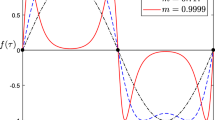Summary
When several oscillators are coupled together and the parameters of their coupling are varied, the oscillators pass through so-called phase-locked regimes. In physical terms this means that the oscillators tend to synchronize their motion. To describe this phenomenon, we frame the concepts ofpartial phase andphase-locking. A partial phase of a toral flow puts emphasis on how orbits of the flow drift around the torus in some fixed direction. The partial phase is locked if it grows in time along some orbit slower than any linear function. When a toral flow is given by a trigonometric polynomial, its phase-locked regions are quite narrow. With the coupling amplitude increasing, each region grows in width as some power of the amplitude. That power can be calculated in terms of both the partial phase and degree of the trigonometric polynomial.
Similar content being viewed by others
References
V. I. Arnold (1961). Small denominators I. Mappings of the circumference onto itself.Izv. Akad. Nauk SSSR Ser. Mat. 25, 21–86 [Am. Math. Soc. Transl. Ser. 2 46 (1965), 213–284].
V. I. Arnold (1963). Small denominators and problems of stability of motion in classical and celestial mechanics.Usp. Mat. Nauk 18:6, 91–192 [Russian Math. Surveys 18:6 (1963), 91–192].
V. I. Arnold (1983a).Geometrical Methods in the Theory of Ordinary Differential Equations. New York, Springer-Verlag.
V. I. Arnold (1983b). Remarks on the perturbation theory for problems of Mathieu type.Usp. Mat. Nauk 38:4, 189–203 [Russian Math. Surveys 38:4 (1983), 215–233].
P. B. Ashwin, J. Guaschi, and G. P. King (1991). Rotation sets and phase-locking in a three oscillator system. Warwick Preprints58.
C. Baesens, J. Guckenheimer, S. Kim, and R. S. MacKay (1991a). Simple resonance regions of torus diffeomorphisms. IMA Volume in Mathematics and Its Applications 37. New York, Springer-Verlag, pp. 1–9.
C. Baesens, J. Guckenheimer, S. Kim, and R. S. MacKay (1991b). Three coupled oscillators: Mode-locking, global bifurcations and toroidal chaos.Physica D 49, 387–475.
R. E. Ecke, J. D. Farmer, and D. K. Umberger (1989). Scaling of the Arnold tongues.Nonlinearity 2, 175–196.
J. Franks and M. Misiurewicz (1990). Rotation sets of toral flows.Proc. Am. Math. Soc. 109, 243–249.
O. G. Galkin (1989). Resonance regions for Mathieu type dynamical systems on a torus.Physica D 39, 287–298.
K. Geist and W. Lauterborn (1990). The nonlinear dynamics of the damped and driven Toda chain, II. Fourier and Lyapunov analysis of tori.Physica D 41, 1–25.
C. Grebogi, E. Ott, and J. A. Yorke (1985). Attractors on anN-torus: Quasiperiodicity versus chaos.Physica D 15, 354–373.
G. R. Hall (1984). Resonance zones in two-parameter families of circle homeomorphisms.SIAM J. Math. Anal. 15, 1075–1081.
A. Khintchine (1963).Continued Fractions. Groningen, Nordhorff.
S. Kim, R. S. MacKay, and J. Guckenheimer (1989). Resonance regions for families of torus maps.Nonlinearity 2, 391–404.
P. S. Linsay and A. W. Cumming (1989). Three-frequency quasiperiodicity, phase-locking, and the onset of chaos.Physica D 40, 196–217.
M. Misiurewicz and K. Ziemian (1989). Rotation sets for maps of tori.J. London Math. Soc. 40, 490–506.
A. I. Neishtadt (1984). On the separation of motions in the systems with rapidly rotating phases.Prikl. Mat. Mekh. 48:2, 197–204.
S. Newhouse, J. Palis, and F. Takens (1983). Bifurcations and stability of families of diffeomorphisms.Publ. Math. IHES 57, 5–72.
S. E. Newhouse, D. Ruelle, and F. Takens (1978). Occurrence of strange axiomA attractors near quasiperiodic flows on Tm,m ≥ 3.Commun. Math. Phys. 64, 35–40.
D. Ruelle and F. Takens (1971). On the nature of turbulence.Comm. Math. Phys. 20, 167–192.
Author information
Authors and Affiliations
Additional information
Communicated by Anatoly Neishtadt
Rights and permissions
About this article
Cite this article
Galkin, O.G. Phase-locking for dynamical systems on the torus and perturbation theory for mathieu-type problems. J Nonlinear Sci 4, 127–156 (1994). https://doi.org/10.1007/BF02430630
Received:
Accepted:
Issue Date:
DOI: https://doi.org/10.1007/BF02430630




